The Utilization of Multiple-Walled Carbon Nanotubes in Polymer Modified Bitumen
Abstract
:1. Introduction
2. Experiments
2.1. Materials
2.2. Preparation of MWCNTs/SBS Modified Bitumen
- (1)
- 3.5% SBS (determined by weight) was added to 90A virgin asphalt which was at a temperature of 160 °C. The mixture was stirred using a high-speed shearing mixer at 5000 rpm for one hour.
- (2)
- The temperature of the SBS modified bitumen was maintained at 160 °C by heating using an oil bath.
- (3)
- MWCNTs were steadily added into the bitumen for 30 min with a high-speed shearing mixer running at 5000 rpm.
- (4)
- Finally, the high-speed shearing mixer at 5000 rpm was applied for 30 min to disaggregate and disperse the agglomerated MWCNTs into the bitumen matrix. High-speed shearing and intelligent temperature control device was showed in Figure 2. In addition, the normal properties of 90A bitumen and SBS modified bitumen were showed in Table 2.
2.3. Instrument and Performance Tests
2.3.1. Conventional Bitumen Tests
2.3.2. Brookfield Viscosity
2.3.3. Dynamic Shear Rheometer (DSR) Tests
2.3.4. Bending Beam Rheometer (BBR) Tests
2.3.5. Modification Mechanism Characterization
2.3.6. Experimental Program Outline
3. Results and Discussion
3.1. Performance Analysis
3.1.1. Conventional Test Analysis
3.1.2. Brookfield Viscosity Test Analysis
3.1.3. DSR Analysis
3.1.4. BBR Analysis
3.2. Modification Mechanism
3.2.1. Far Infrared Spectrum Analysis
3.2.2. Bitumen Four Components Analysis
3.2.3. Thermal Analysis
3.2.4. Fluorescence Microscopy Test
4. Conclusions
- MWCNTs as an additive had a positive effect on the performances of the SBS modified bitumen. The optimum concentration of MWCNTs in SBS modified bitumen was determined as 1.0%.
- The Brookfield rotational viscosity test showed that the MWCNTs as an additive improved the high temperature susceptibility of the SBS bitumen. The DSR test showed that MWCNTs could improve the high temperature property of the SBS modified bitumen and the BBR test indicated that MWCNTs improved the low temperature crack resistance.
- The IR test revealed that there is no new chemical functional groups formed by the addition of MWCNTs. The bitumen four components test showed that MWCNTs as an additive to SBS modified bitumen result in changes in the content of each component. The thermal analysis test confirmed that the MWCNTs improved the thermal stability of the SBS modified bitumen and the light components decomposed at a slower rate. In addition, the fluorescence microscopy test showed that the MWCNTs improved the dispersion and storage stability of SBS in bitumen. A schematic was proposed by the strong adsorption property due to π–π interaction between MWCNTs and organic molecules that containing benzene rings, to explain why MWCNTs had a positive effect on the SBS modified bitumen. It was suggested that MWCNTs act like a ‘bridge’; one of its ends had a π–π conjugated complex with the polystyrene of SBS, and the other side had a π–π conjugate interaction with the aromatic molecules. There was a better compatibility of polystyrene and for that reason, more saturates and aromatics filtered into the network structure of SBS and then a stronger network structure consisting of SBS, light components of bitumen, and MWCNTs in the MWCNT/SBS modified bitumen was formed. The improved high and low temperature performance was attributed to the stronger network structure. Further study is needed to directly confirm the existence of π–π interactions between the polystyrene of SBS and the MWCNTs in bitumen.
Acknowledgments
Author Contributions
Conflicts of Interest
References
- Liang, M.; Liang, P.; Fan, W.; Qian, C.; Xin, X.; Shi, J.; Nan, G. Thermo-rheological behavior and compatibility of modified bitumen with various styrene-butadiene structures in SBS copolymers. Mater. Des. 2015, 88, 177–185. [Google Scholar] [CrossRef]
- Saifuddin, N. Carbon Nanotubes: A Review on structure and their interaction with Proteins. J. Chem. 2012, 2013, 634–652. [Google Scholar] [CrossRef]
- Chen, H.; Wang, X.; Gang, Z.; Zu, Y. Performance of nano-modification bitumen. Highw. Eng. 2008, 22, 133–135. [Google Scholar]
- Shafabakhsh, G.; Ani, O. Experimental investigation of effect of nano-TiO2/SiO2, modified bitumen on the rutting and fatigue performance of bitumen mixtures containing steel slag aggregates. Constr. Build. Mater. 2015, 98, 692–702. [Google Scholar] [CrossRef]
- Fang, C.; Yu, R.; Liu, S.; Li, Y. Nanomaterials applied in bitumen modification: A Review. J. Mater. Sci. Technol. 2013, 29, 589–594. [Google Scholar] [CrossRef]
- Yang, J.; Tighe, S. A Review of advances of nanotechnology in bitumen mixtures. Procedia Soc. Behav. Sci. 2013, 96, 1269–1276. [Google Scholar] [CrossRef]
- You, Z.; Beale, J.; Foley, J.; Roy, S.; Odegard, G.; Dai, Q.; Goh, S. Nano-clay modified bitumen materials: Preparation and characterization. Constr. Build. Mater. 2011, 25, 1072–1078. [Google Scholar] [CrossRef]
- Ajayan, P. Nanotubes from carbon. Chem. Rev. 1999, 99, 1787–1799. [Google Scholar] [CrossRef] [PubMed]
- Reilly, R. Carbon nanotubes: Potential benefits and risks of nanotechnology in nuclear medicine. J. Nucl. Med. 2007, 48, 1039–1042. [Google Scholar] [CrossRef] [PubMed]
- Hamers, B.; Pgaj, S.; Veld, M. The Wondrous World of Carbon Nanotubes; Eindhoven University of Technology: Eindhoven, The Netherlands, 2003. [Google Scholar]
- Amin, I.; El-Badawy, S.; Breakah, T.; Ibrahim, M. Laboratory evaluation of bitumen binder modified with carbon nanotubes for Egyptian climate. Constr. Build. Mater. 2016, 121, 361–372. [Google Scholar] [CrossRef]
- Yang, J.; Wang, S.; Zhou, X.; Xie, J. Electrochemical behaviors of functionalized carbon nanotubes in LiPF6/EC+DMC Electrolyte. Int. J. Electrochem. Sci. 2012, 7, 6118–6126. [Google Scholar]
- Faramarzi, M.; Arabani, M.; Haghi, A.; Mottaghitalab, V. Carbon nanotubes-modified bitumen binder: Preparation and characterization. Int. J. Pavement Res. Technol. 2015, 8, 23–27. [Google Scholar]
- Santagata, E.; Baglieri, O.; Tsantilis, L.; Dalmazzo, D. Rheological characterization of bituminous binders modified with carbon nanotubes. Procedia Soc. Behav. Sci. 2012, 53, 546–555. [Google Scholar] [CrossRef]
- Fu, H.; Xie, L.; Dou, D.; Li, L.; Yu, M.; Yao, S. Storage stability and compatibility of bitumen binder modified by SBS graft copolymer. Constr. Build. Mater. 2007, 21, 1528–1533. [Google Scholar] [CrossRef]
- Standard Test Methods of Bitumen and Bituminous Mixtures for Highway Engineering; JTG E20-2011; Highway Science Research Institute of the Ministry of Transport: Beijing, China, 2011.
- Standard Method of Test for Determining the Rheological Properties of Asphalt Binder Using a Dynamic Shear Rheometer (DSR); AASHTO DT 315-08; AASHTO: West Conshohocken, PA, USA, 2008.
- Petersen, J.; Robertson, R.; Branthaver, J. Binder Characterization and Evaluation; Strategic Highway Research Program, National Research Council: Washington, DC, USA, 1994. [Google Scholar]
- Mohamed, A.; Christopher, W. Determination of pre-treatment procedure required for developing bio-binders from bio-oils. In Proceedings of the 2009 Mid-Continent Transportation Research Symposium, Ames, IA, USA, 20–21 August 2009. [Google Scholar]
- ASTM D2493/D2493M-09, Standard Viscosity-Temperature Chart for Bitumens; ASTM International: West Conshohocken, PA, USA, 2009.
- Wu, S.; Cong, P.; Yu, J.; Mo, L. Experimental investigation of related properties of bitumen binders containing various flame retardants. Fuel 2006, 85, 1298–1304. [Google Scholar] [CrossRef]
- Amir, G.; Magdy, A. Composition analysis of crumb rubber during interaction with bitumen and effect on properties of binder. Int. J. Pavement Eng. 2013, 14, 517–530. [Google Scholar]
- Hassan, M.; Dylla, H.; Mohammad, L.; Rupnow, T. Evaluation of the durability of titanium dioxide photocatalyst coating for concrete pavement. Constr. Build. Mater. 2010, 24, 1456–1461. [Google Scholar] [CrossRef]
- Zhu, C.; Yang, Y.; Liu, X. Comparative analysis of different grade bitumen bending beam rheological test. J. China Foreign Highw. 2007, 27, 289–291. [Google Scholar]
- Wang, T.; Cai, H.; Zhang, Y. Research about the mechanism of SBS modified bitumen. Pet. Bitum. 2008, 22, 21–24. [Google Scholar]
- Planche, J.; Claudy, P.; Létoffé, J.; Martin, D. Using thermal analysis methods to better understand bitumen rheology. Thermochim. Acta 1998, 324, 223–227. [Google Scholar] [CrossRef]
- Loeber, L.; Muller, G.; Morel, J.; Sutton, O. Bitumen in colloid science: A chemical, structural and rheological approach. Fuel 1998, 77, 1443–1450. [Google Scholar] [CrossRef]
- Benbouzid, M.; Hafsi, S. Thermal and kinetic analyses of pure and oxidized bitumen. Fuel 2008, 87, 1585–1590. [Google Scholar] [CrossRef]
- Rao, V.; Johns, J. Thermal behavior of chitosan/natural rubber latex blends TG and DSC analysis. J. Therm. Anal. Calorim. 2008, 92, 801–806. [Google Scholar] [CrossRef]
- Yu, H.; Leng, Z.; Gao, Z. Thermal analysis on the component interaction of bitumen binders modified with crumb rubber and wa rm mix additives. Constr. Build. Mater. 2016, 125, 168–174. [Google Scholar] [CrossRef]
- Chen, R.; Zhang, Y.; Wang, D.; Dai, H. Noncovalent sidewall functionalization of single-walled carbon nanotubes for protein immobilization. J. Am. Chem. Soc. 2001, 123, 3838–3839. [Google Scholar] [CrossRef] [PubMed]
- Lin, D.; Xing, B. Adsorption of phenolic compounds by carbon nanotubes: Role of Aromaticity and Substitution of Hydroxyl Groups. Environ. Sci. Technol. 2008, 42, 7254–7259. [Google Scholar] [CrossRef] [PubMed]
- Chen, W.; Duan, L.; Wang, L.; Zhu, D. Adsorption of hydroxyl- and amino-substituted aromatics to carbon nanotubes. Environ. Sci. Technol. 2008, 42, 6862–6868. [Google Scholar] [CrossRef] [PubMed]

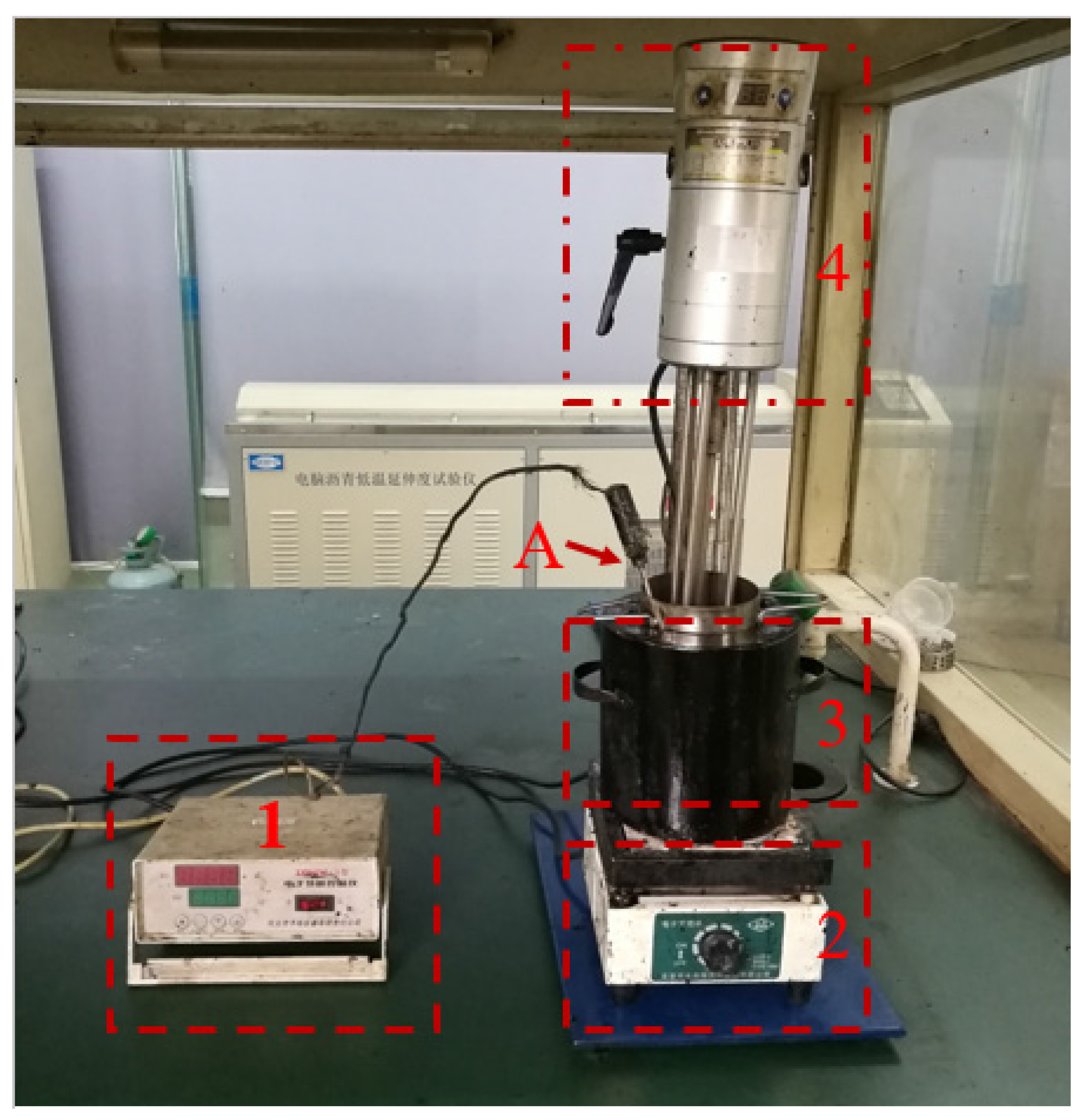
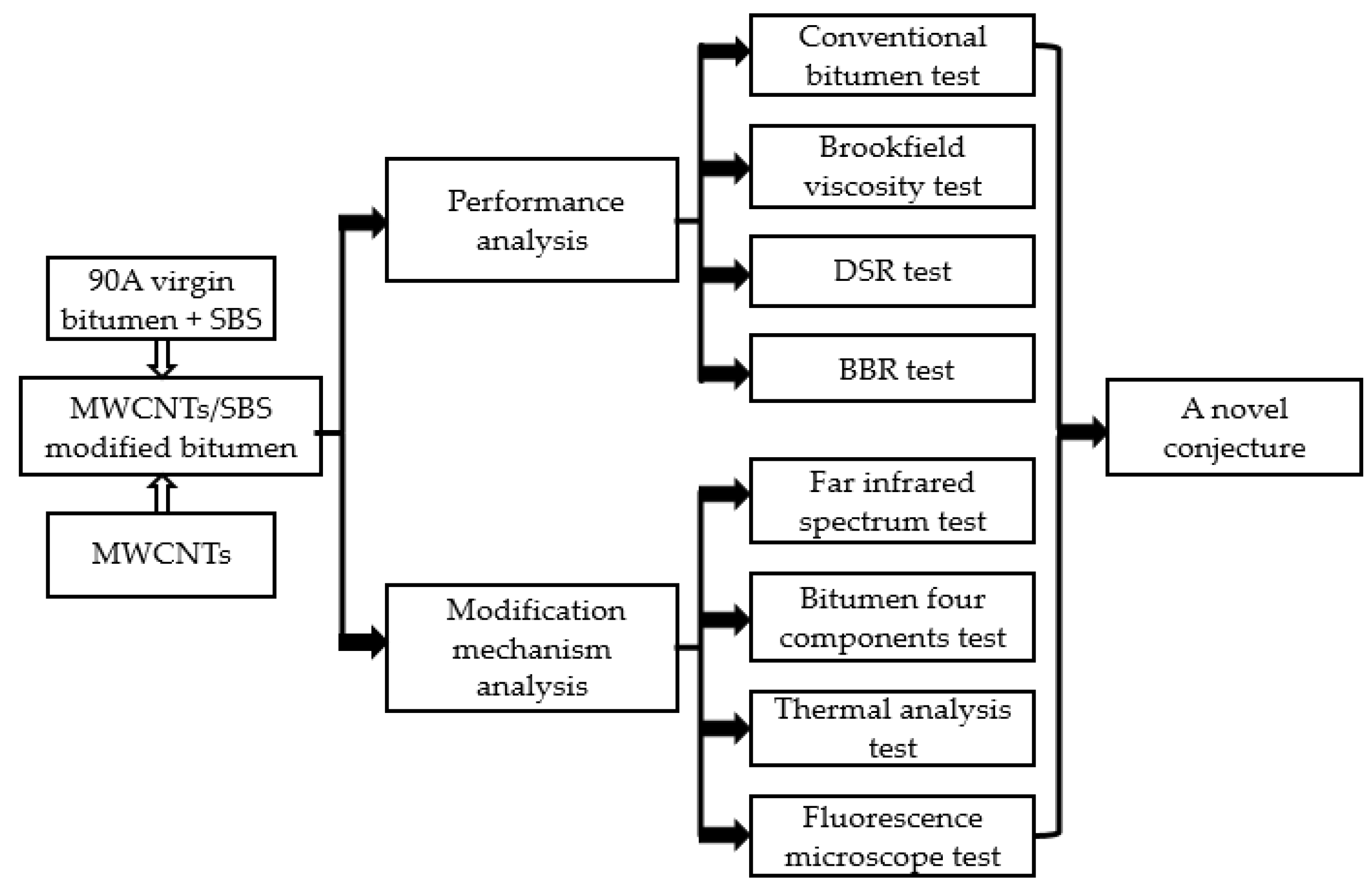
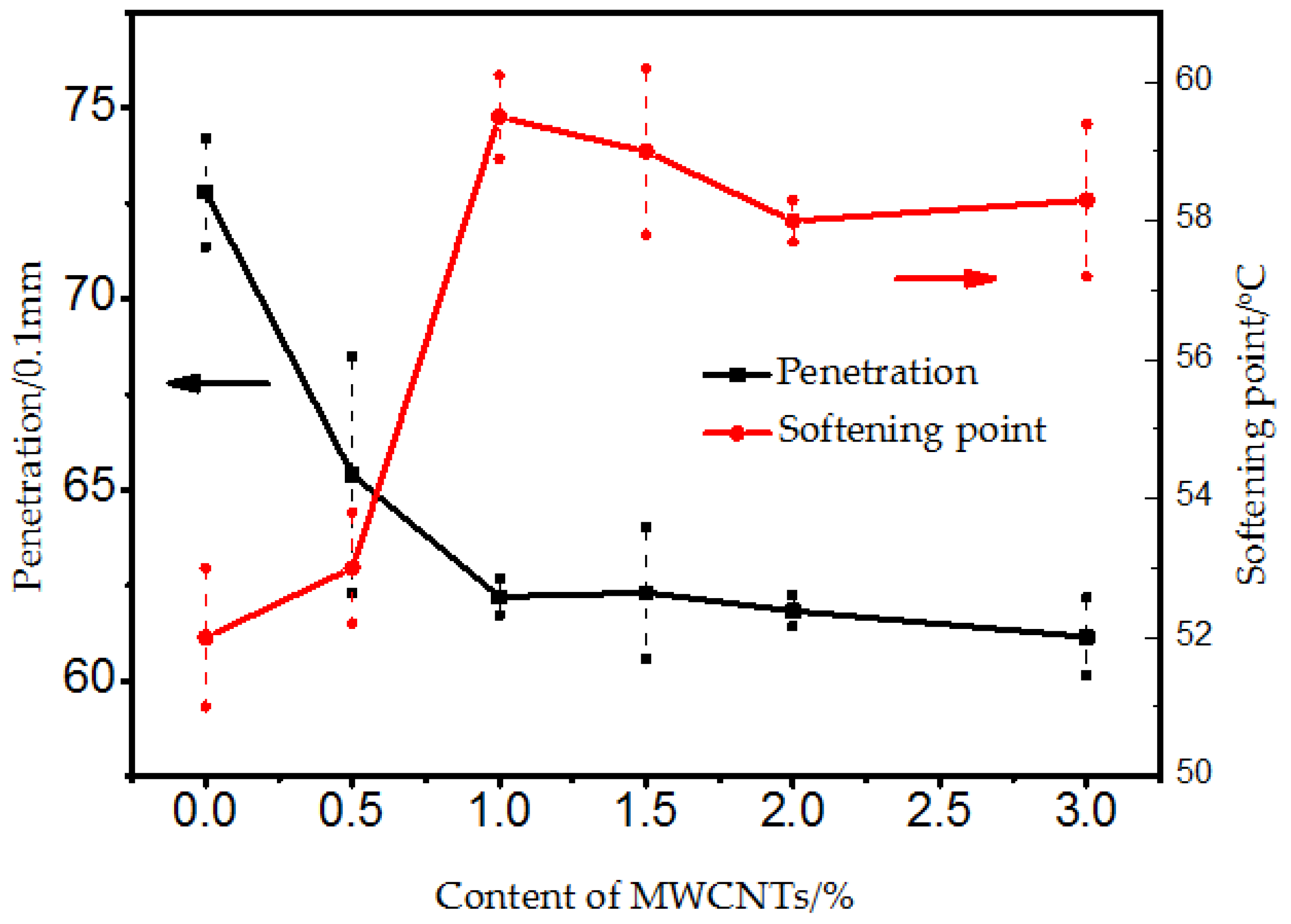
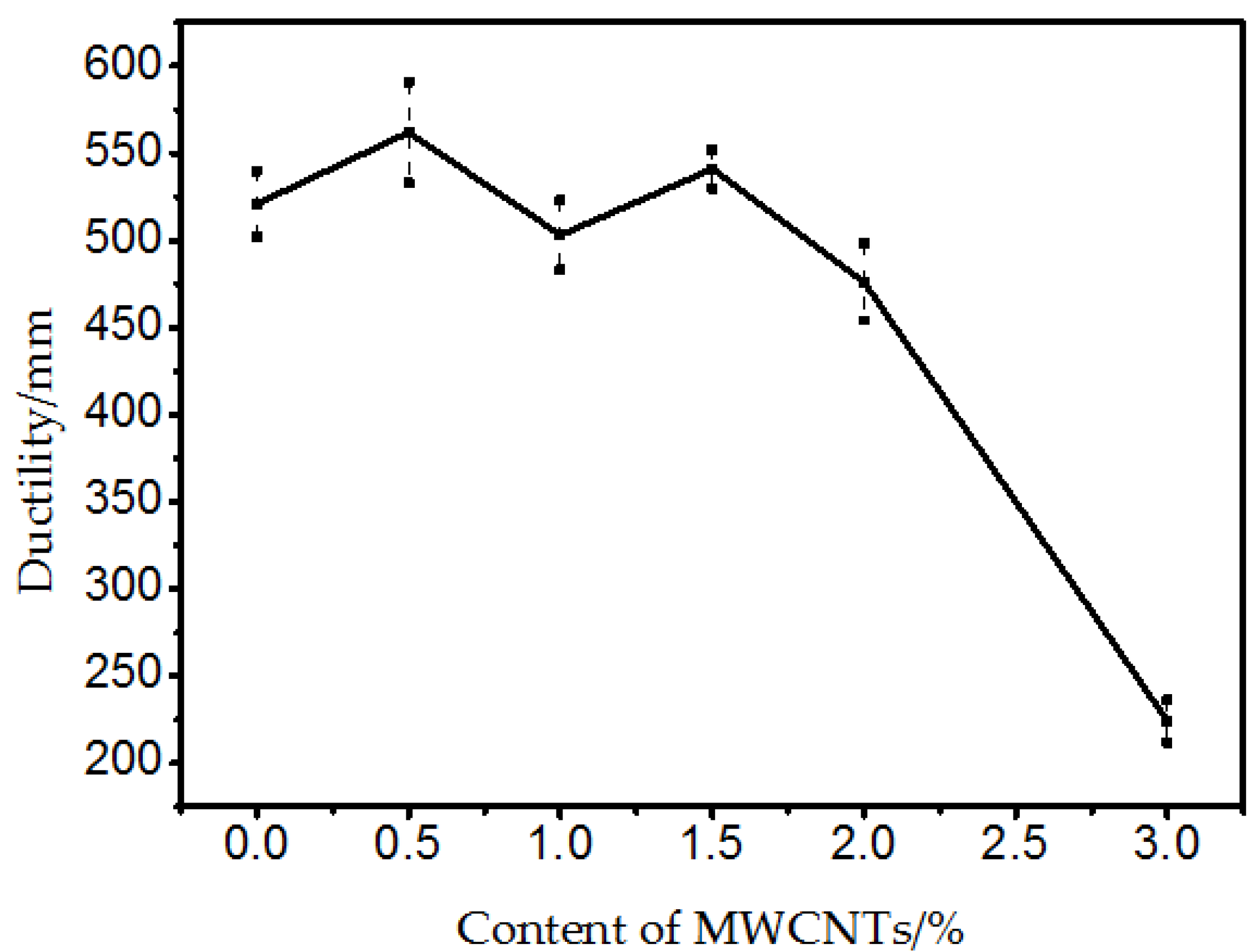
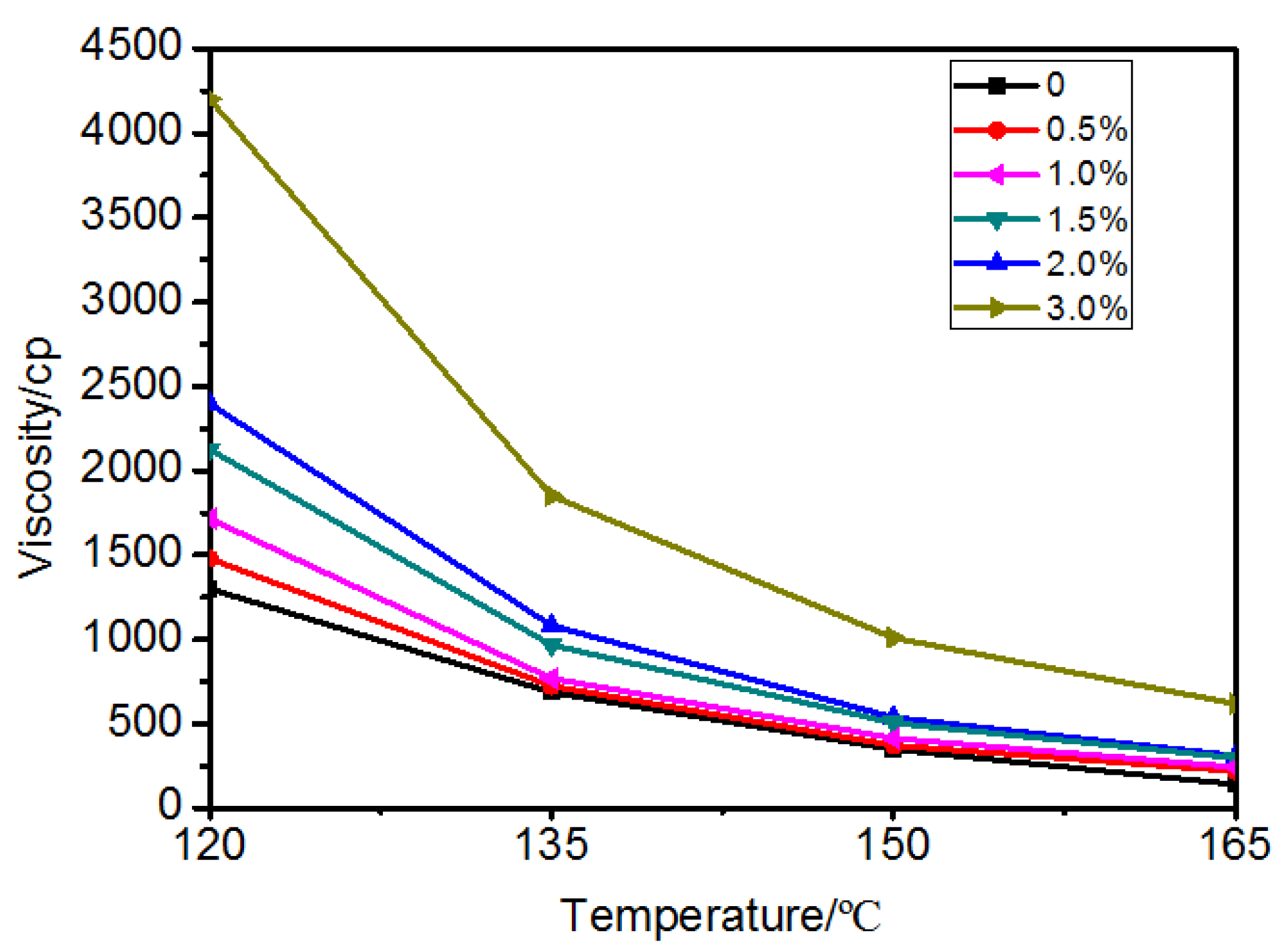
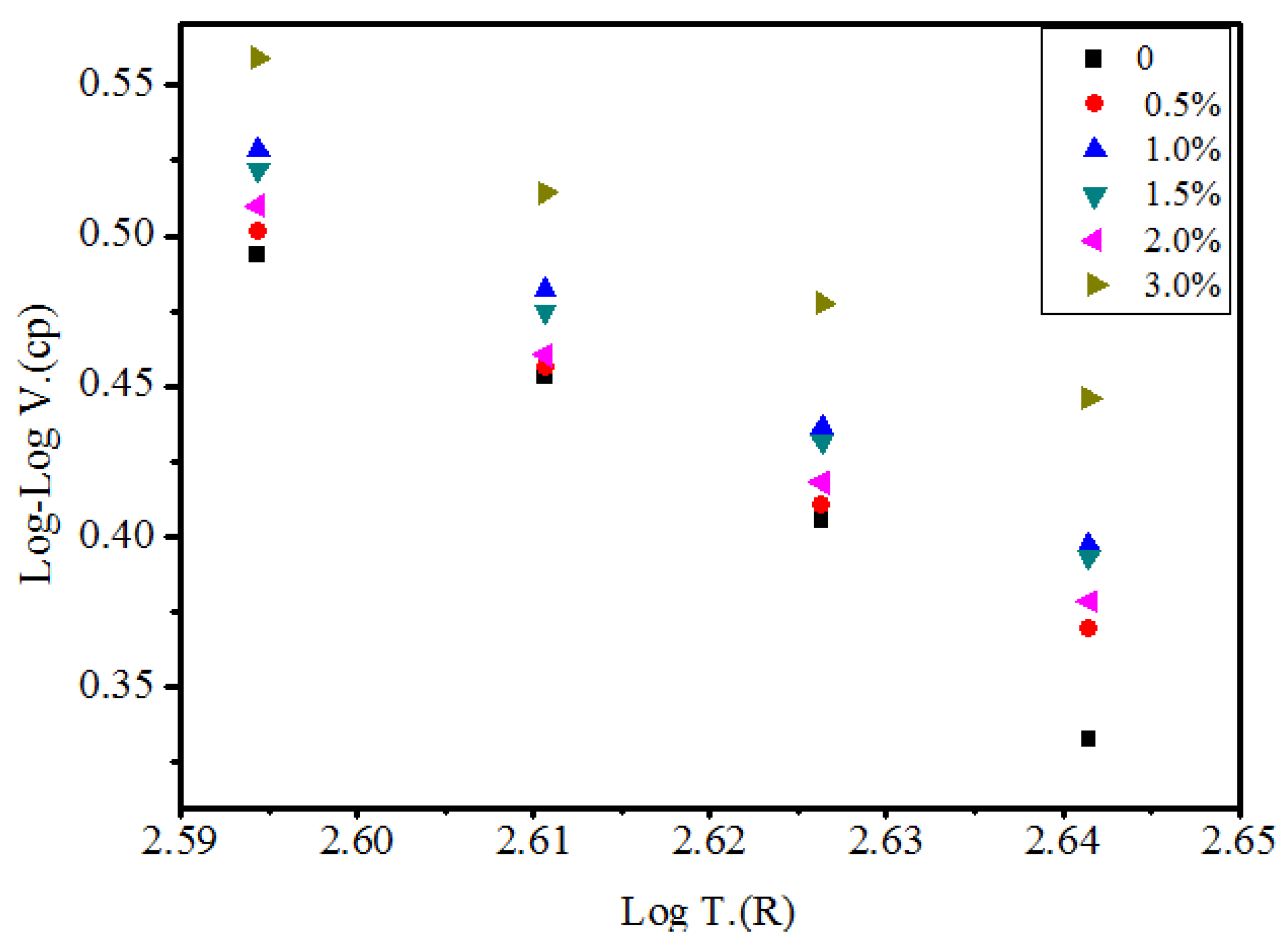



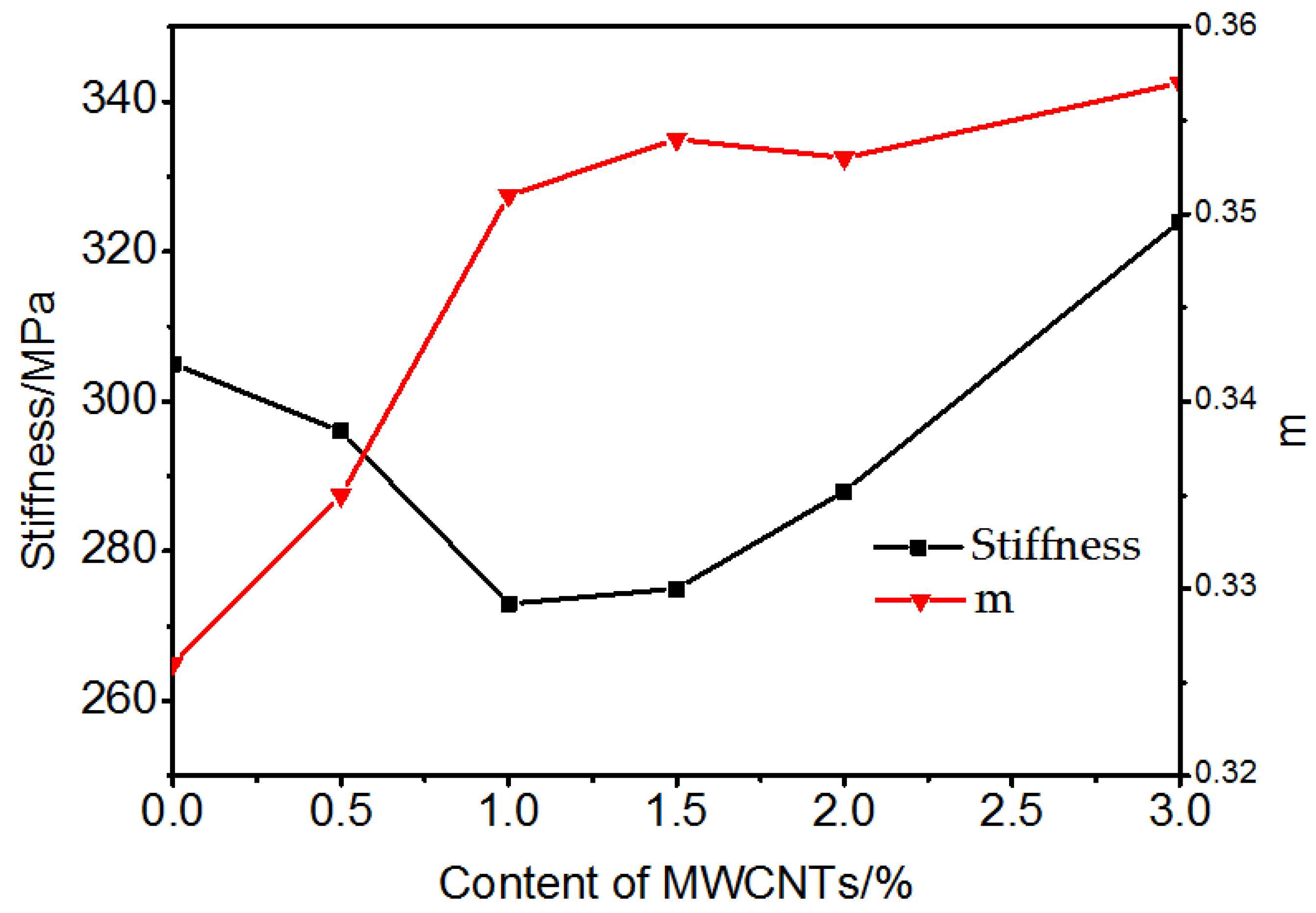
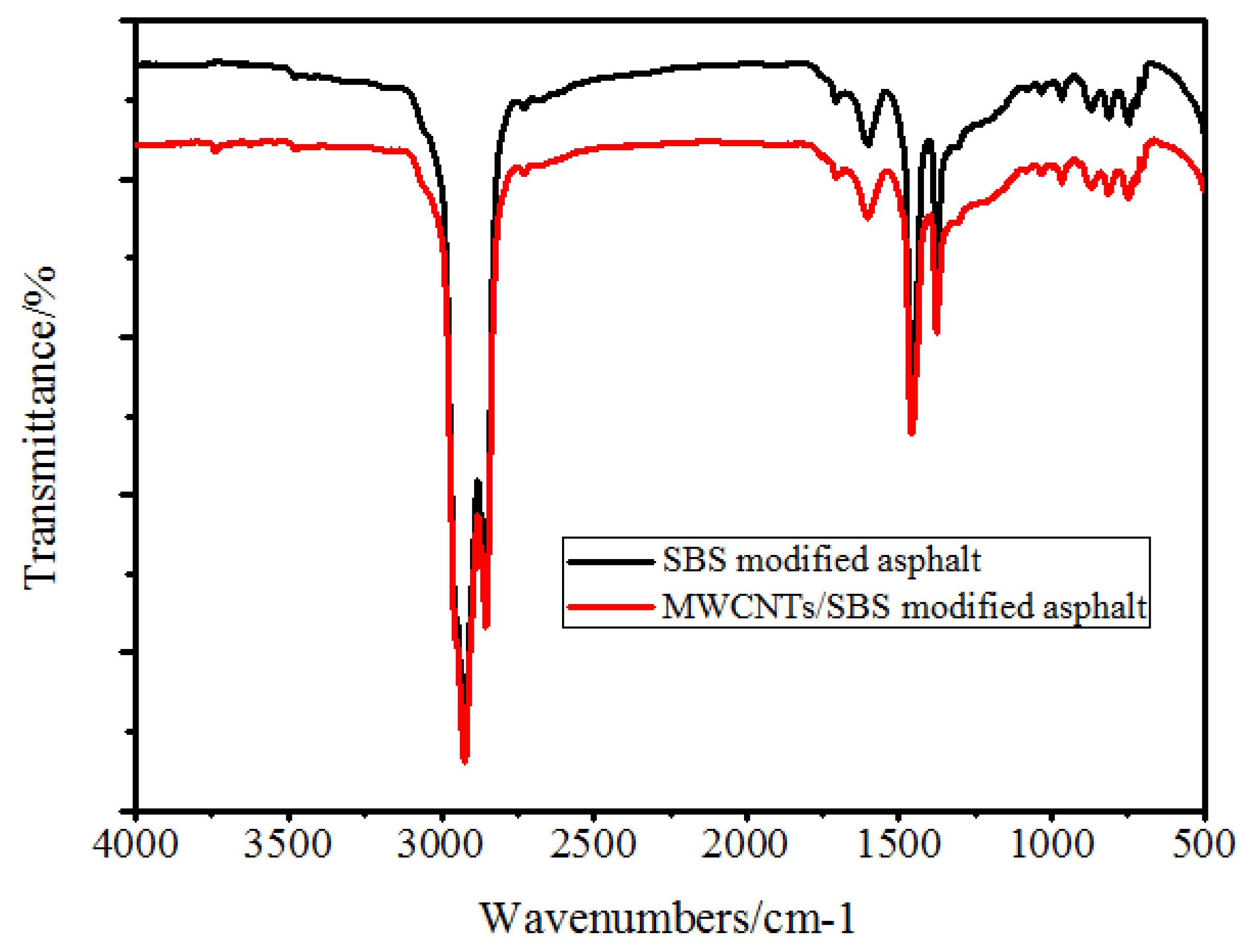
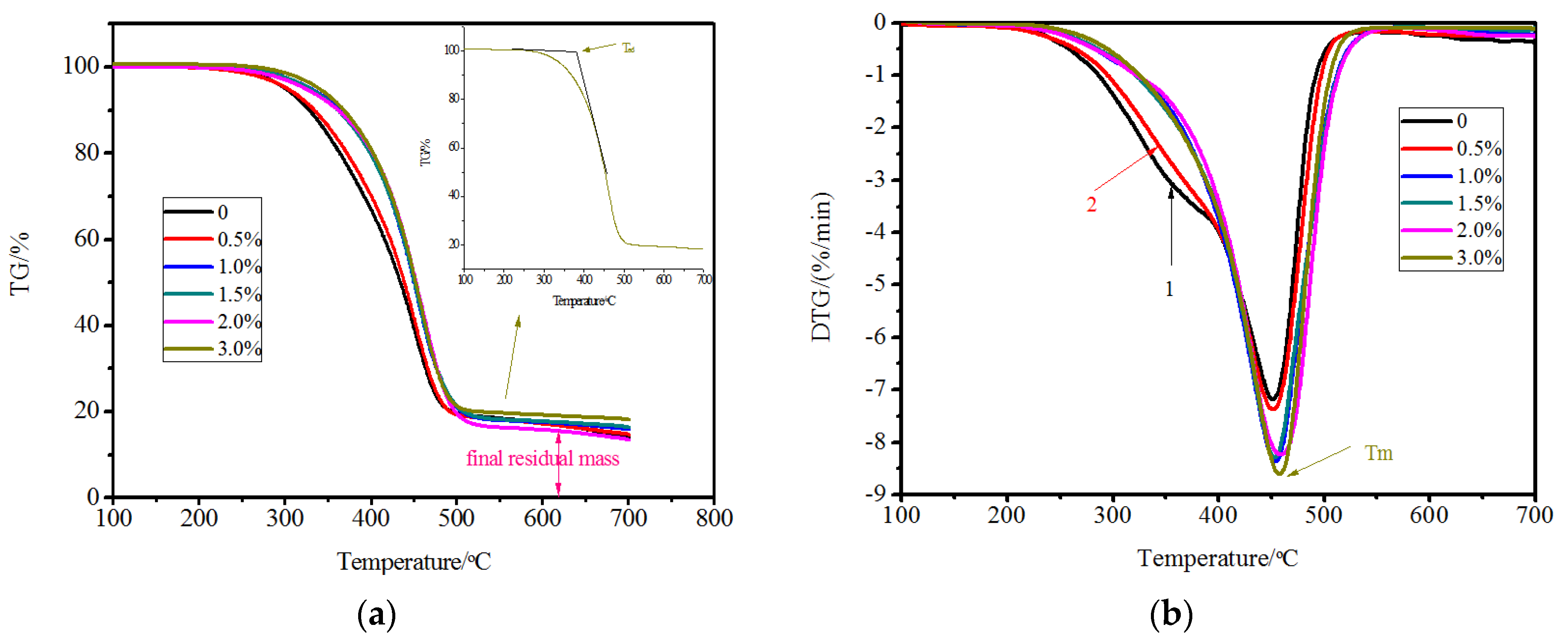

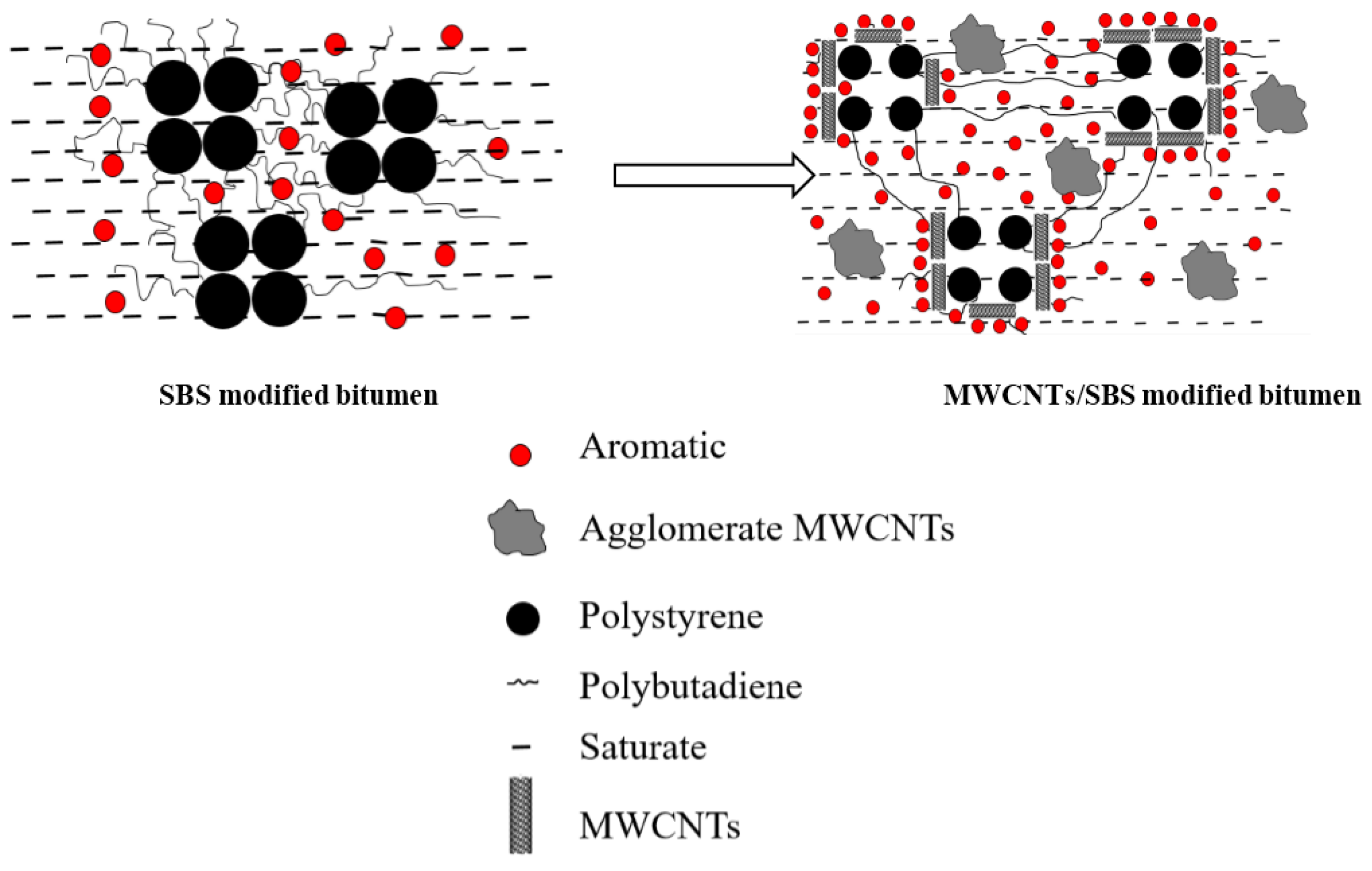
| Purity | Internal Diameter | Outside Diameter | Length | Surface Area | Density | Preparation Method |
|---|---|---|---|---|---|---|
| >95/% (by weight) | 3–5 nm | 8–10 nm | 3–12 μm | >200 m2/g | 0.1 g/cm3 | Chemical vapor deposition |
| Physical Properties | 90A | SBS Modified Bitumen |
|---|---|---|
| Penetration (25 °C, 0.1 mm) | 84.7 | 72.8 |
| Softening point (°C) | 47.8 | 52.0 |
| Ductility (5 cm/min, 5 °C, 1 mm) | / | 521 |
| Viscosity (135 °C, pa·s) | 0.47 | 0.69 |
| Content of MWCNTs/% | 0 | 0.5 | 1.0 | 1.5 | 2.0 | 3.0 |
|---|---|---|---|---|---|---|
| VTS | −3.3642 | −2.8098 | −2.8135 | −2.7363 | −2.783 | −2.4001 |
| R2 | 0.9765 | 0.9997 | 0.9994 | 0.9992 | 0.9987 | 0.9961 |
| The Percentage of MWCNTs/% | The Content of Components/% | |||
|---|---|---|---|---|
| Saturation | Aromatic | Resin | Asphaltene | |
| 0 | 17.27 | 45.22 | 32.65 | 4.86 |
| 0.5 | 15.99 | 44.52 | 34.12 | 5.37 |
| 1.0 | 14.50 | 42.19 | 37.85 | 5.46 |
| 1.5 | 14.11 | 42.18 | 38.08 | 5.63 |
| 2.0 | 14.04 | 42.29 | 38.17 | 5.50 |
| 3.0 | 14.32 | 42.01 | 37.74 | 5.93 |
| The Percentage of MWCNTs/% | Ted/°C | Tm/°C | Mf/% |
|---|---|---|---|
| 0 | 364.5 | 451.4 | 14.23 |
| 0.5 | 374.1 | 451.4 | 14.78 |
| 1.0 | 390.9 | 453.7 | 15.92 |
| 1.5 | 393.9 | 453.3 | 16.52 |
| 2.0 | 397.9 | 459.2 | 13.61 |
| 3.0 | 397.1 | 457.6 | 18.30 |
© 2017 by the authors. Licensee MDPI, Basel, Switzerland. This article is an open access article distributed under the terms and conditions of the Creative Commons Attribution (CC BY) license (http://creativecommons.org/licenses/by/4.0/).
Share and Cite
Shu, B.; Wu, S.; Pang, L.; Javilla, B. The Utilization of Multiple-Walled Carbon Nanotubes in Polymer Modified Bitumen. Materials 2017, 10, 416. https://doi.org/10.3390/ma10040416
Shu B, Wu S, Pang L, Javilla B. The Utilization of Multiple-Walled Carbon Nanotubes in Polymer Modified Bitumen. Materials. 2017; 10(4):416. https://doi.org/10.3390/ma10040416
Chicago/Turabian StyleShu, Benan, Shaopeng Wu, Ling Pang, and Barugahare Javilla. 2017. "The Utilization of Multiple-Walled Carbon Nanotubes in Polymer Modified Bitumen" Materials 10, no. 4: 416. https://doi.org/10.3390/ma10040416







